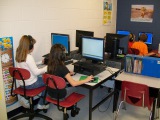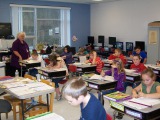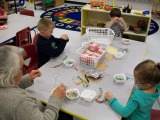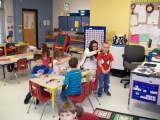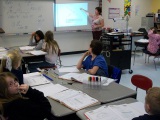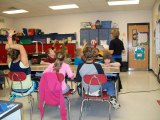-
Category 2
Selected in 2012
-
Grades: pre k - 5
School Setting: rural
Town Population: 500
Student Enrollment: 256
Student Demographics:
Black/African American: 0%
Teacher/Student Ratio: 1:18
White/Caucasian: 100%
Hispanic: 0%
Hawaiian/Pacific Islander: 0%
Asian: 0%
Native American: 0%
Other: 0%
% Reduced Lunch: 94%
% ELL Learners: 0%
Founded: 2007 -
PRINCIPAL:
Anthony Boggs -
CONTACT:
59 Ossia Road
Duck, WV 25063
304-286-3111
asboggs@access.k12.wv.us
Big Otter Elementary
Duck, WV
Title I funds are essential to our success, as the funding allows us to provide high quality professional development to our staff. Also, due to these funds we are able to employee two reading specialist at Big Otter Elementary. Further, as professional educators, we understand how vital it is for families to be involved in their child’s education so we use Title I funds to support parent trainings on topics, such as, What is Tier Instruction, and How Can I Help My Child at Home?
- Describe specific programs in place to ensure that families are involved in the success of your school and students.
- As stated previously, we understand that parents are vital to the success of the school. We encourage them to become active participants in their child’s education not passive observers. Therefore, we offer them many opportunities to volunteer at school. We encourage them to assist in our after school program, to serve on our Local School Improvement Council, to join our Parent Teacher organization, and to serve on our Parent Advisory Council. These are only a few of the many ways a parent can become involved at their child’s school. Also, throughout the year we provide trainings for parents. These trainings “arm” parents with essential strategies and skills needed to assist their children.
- Describe the most successful activity your school has initiated to strengthen the ties to your community.
-
Our school is the “heart” of the community and we have many activities that involve the community, thus, strengthening the ties between our community and our school. For example, we have programs, such as a Veterans’ Day Program and we invite the public to these types of events. During this event, every child in the school participates in some way. A child may sing, dance, read poetry, or perform in a play, but every child gets an opportunity to showcase his or her talent. Also, we host a Christmas Program and invited the public and again every child performs. The children love this and so does the public.
We also have “Student of the Month Luncheons” and invite parents to come to school and have lunch with their child. In addition, our library is ran and operated by our parents. We do not have a librarian so our parents “stepped up to the plate” and they do an outstanding job with the library. If you visited our library, you would think we have at least two full time librarians, but we do not. What we do have is a group of parents who are avid readers and they want the Big Otter Braves to become avid readers so the library is always open.
We want our school to be the focal point of the community so we keep the community well informed about what is happening at Big Otter Elementary School. We have a school website, the teachers send home classroom newsletters, the principal does a monthly newsletter, and parents email us. The lines of communication between community and school make for strong ties to the community.
Also, our school is open four nights a week for Little League Basketball. The coaches of this league are parents from our community. Further, four nights a week we have after school and we encourage the community to help with this program. They can read to small groups of students or they may tutor a child. We want parents to be involved. Getting involved in school programs may just change a child’s life. And it could be your child’s life that changes for the better. - Describe your philosophy of school change or improvement.
-
Our team believes change is sometimes difficult but it is essential to success. In order for a school to improve there must be change for without change we never evolve we remain the same. Our philosophy of school change or improvement is nothing new. We believe in order to improve a school; you must constantly analysis student data. You need to look at student data and asked tough questions: What is working? What is not working? What do we need to change to improve our school? How do we bring about change and who will be responsible for what during this period of change?
We are in the business of educating children. In order to be effective at our jobs, we must be willing to become life-long learners and bring new skills, new tools, new ideas to the classrooms so our practices will continue to be exciting, motivating, and innovating. - What are your school’s top two goals for the next year?
-
One of Big Otter Elementary School’s goals is, and will continue to be, student achievement. While we are very proud of our fourth and fifth grade teachers and students, we will continue to raise the bar on student achievement and strive to increase our achievement scores. We will continue to set lofty goals and seek to ensure each and every Big Otter Brave achieves mastery or above. Further, for the 2013-2014 school year, we will seek to provide the resources, assistance, training, etc. to our third grade students and teachers, to increase their achievement data to not merely be consistent with state and county averages, but to exceed those averages.
To achieve these goals we will continue to analyze the most recent student achievement data and teacher observations. We will continue to examine our master schedule to ensure the needs of all our students our met. We will utilize our master schedule to increase the amount of instructional time designated to the teaching of mathematics, reading, and writing. Further, we need to continue to ask questions that will assist us in the meeting the needs of Big Otter Elementary students, such as, are we using our staff effectively? Are we teaching 21st Century Content? Have we implemented effective Walk to(s)? Does our staff participate in high quality professional staff development? Are we utilizing our resource staff effectively?
Our second goal is, as educators we understand the need for a "meaningful" parentental involvement program and understand that parentental support is crucial to a school’s success. That is why the decision was made to strengthen our parent involvement program. We worked hard to implement a Parent / Teacher Organization, a strong volunteer program, and various ways for parents to have a voice in the decision making process. Our first year was difficult (2007-2008). It was a difficult task to merge two school cultures. During the 2008-2009 school year we saw an increase in the number of parents who volunteered at Big Otter Elementary. This year we want to see an even greater number of parents making a commitment to the Big Otter Braves. Parent involvement is a priority for us. We want to continue to build a relationship with our parents and community members. We understand and accept the impact that parents have upon education. Research indicates that parent involvement increases student achievement, student attendance, student expectations, to name only a few ways parents can impact the learning process. As such, this year a focus will be on increase attendance at parent involvement activities. We have in place a Read Aloud, where grandparents, community members, teachers, and Principals read to students. - What is the single most important factor in the success of your school that others could replicate?
-
In order to answer this question, I need to provide you with some background information. Currently, Big Otter Elementary School is five years old. Our school was established in 2007 with the closing of Ivydale Elementary School and Valley Fork Elementary School. Our first goal was to bring two schools together to work effectively as one. In the beginning, we had two schools under one roof. We were still the Ivydale Wild Cats and the Valley Fork Rockets. The only difference- now we are under the same roof. We knew this had to change. We had to become the Big Otter Braves. However, the question was where to begin? The answer was obvious – We started with the school climate.
Our team would tell you we were successful but it wasn’t easy. Today, if you were to visit Big Otter Elementary School you would feel the “warmth.” It is a very welcoming school. You would know the mission of the school because the mission statement is front and center in the foyer. It would not take you long to discover the school colors, as most of the faculty, staff, and students would be wearing red and black. Also, you would discover the school mascot almost immediately, because time and time again throughout the school day you would hear – “It’s a great day to be a Big Otter Brave.” As a visitor, you would see evidence of teams working together to promote student learning and success. You would see these teams planning together and implementing lessons together. You could not help but notice that instruction is data driven, of the highest quality, and student focused.
You may ask, “How was this school climate created?” First, by making sure we remained focused on our goal - to bring two schools together to work effectively as one. Secondly, we took the time to build collaboration among our team members (i.e. parents, students, faculty, staff, and community members). Lastly, the Big Otter Braves made it a priority to celebrate our success. - Describe the program or initiative that has had the greatest positive effect on student achievement.
- Many initiatives have been implemented so a great deal of thought has always been given to the Master Schedule and the instructional role each team member would play throughout the instructional day. One of the programs, we wanted to implement was The Three Tier Reading Model. We felt it was imperative to spend a great deal of time designing a schedule, which would support this reading model. The Three Tier Model is designed to meet the needs of all young readers, including struggling ones. It is usually referred to as the Prevention Model. The model consist of three tiers or levels of instruction: Tier I, Tier II, and Tier III. Tier I is designed to meet the needs of the majority of the school’s students. When Tier I, is not sufficient to meet the needs of some students, then these students are placed in Tier II and are given additional support. A small percentage of students who have received Tier II instruction continue to show marked difficulty in acquiring necessary reading skills are given Tier III instruction. Students are placed in groups but these groups are flexible and students enter and exit as needed based on student data.
- Explain how Title I funds have supported your improvement efforts.
- Title I funds are essential to our success, as the funding allows us to provide high quality professional development to our staff. Also, due to these funds we are able to employee two reading specialist at Big Otter Elementary. Further, as professional educators, we understand how vital it is for families to be involved in their child’s education so we use Title I funds to support parent trainings on topics, such as, What is Tier Instruction, and How Can I Help My Child at Home? These are only a few of the numerous training opportunities we provide parents. In addition, we use funds from this grant to promote the use of technology. In the past, we have used these funds to provide our school with technology tools and specialist to train our staff in the use of these tools. At one point, because we are a Title I School we were fortunate enough to have a Technology Integration Specialist (TIS). We could not provide our teachers or parents with any of the much needed supported without our Title I funding.
- Identify the professional development activities you use to improve the teaching portion of the teaching and learning process.
-
Professional development is the catalyst that promotes change and at Big Otter we know change is essential to success. If an educator refuses to be a learner, I am not sure they can be a teacher. We must be life-long learners so our practice is an effective one. We must create a practice that allows students to develop and grow into successful learners and ultimately productive citizens. We cannot create such a practice if we do not provide high quality professional development to our teachers. One of the professional development opportunities that we offer are the summer academies. During these academies, teachers are given time to work with their colleagues to learn new strategies, new skills, and gain knowledge that will assist them in teaching all the students in their classroom regardless of their ability level.
Another, professional development opportunity that was very beneficial to Big Otter was The Gate’s Award. Our Technology Team was successful in winning this competitive award. As recipients of this award we won a mobile Ipad lab for our school, each team member received an ipad, and we received two years of professional development that focused on integrating technology throughout the curriculum. I believe our entire teaching staff would agree this was an amazing learning experience for us and our students. - Describe how data is used to improve student achievement and inform decision making.
- Data tells us where our students are in terms of achievement. By understanding where we, we are better equipped to make informed decisions about where we want to be and how are we going to get there. Our Curriculum Team understands the importance of data analysis. They understand we need this vital information to continue to improve student achievement. Data drives our instruction. We use data to guide us in developing lesson plans and we use data to helps us group children for differentiation instruction. We use data to evaluate our progress and to answer questions, such as, what’s working and what isn’t? We make recommendations to parents based on data, such as, whether a child should attend after school or summer school. At Big Otter Elementary data is the driving forces behind decisions that effectuate achievement.
- Describe your school culture and explain changes you’ve taken to improve it.
- We worked diligently over the past five years to achieve the school culture we have. The word we use to describe our culture is self-efficacy. Self-efficacy is the belief that you can succeed regardless of the tasks. This level of high expectation saturates the social climate of the school. The students at Big Otter expect to succeed and teachers expect to succeed. This is evident by their mission statement: building learning opportunities by way of education and expecting success. Hand in hand with self-efficacy at Big Otter is mutual respect. The culture is one where we take care of each other, we assist each other, and we value each other. In other words, we strive to make Big Otter the best it can be and we work together to accomplish our goals. At this moment in time, our team agrees we like the culture of our school. We are proud of what we have accomplished in such a short period of time. When we look in the mirror, we like what we see. We wouldn’t change a thing.
Stats
-
Category 2
Selected in 2012
-
Grades: pre k - 5
School Setting: rural
Town Population: 500
Student Enrollment: 256
Student Demographics:
Black/African American: 0%
Teacher/Student Ratio: 1:18
White/Caucasian: 100%
Hispanic: 0%
Hawaiian/Pacific Islander: 0%
Asian: 0%
Native American: 0%
Other: 0%
% Reduced Lunch: 94%
% ELL Learners: 0%
Founded: 2007 -
PRINCIPAL:
Anthony Boggs -
CONTACT:
59 Ossia Road
Duck, WV 25063
304-286-3111
asboggs@access.k12.wv.us


